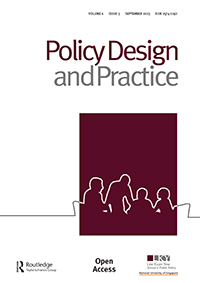The limits of policy labs: characteristics, opportunities and constraints
IF 2.6
Q1 PUBLIC ADMINISTRATION
引用次数: 14
Abstract
Abstract Policy labs are promoted as providing supportive structures and processes for innovation. Their contributions to policy advisory systems are seen as residing in developing creative policy solutions “outside” traditional bureaucratic structures, and in providing experimental sites for solving problems. This paper examines the characteristics of policy labs in terms of their organizational forms, size, focus and the methods that they employ. It then analyses the opportunities and constraints that labs have in relation to policy design. Labs can be government-controlled, government-enabled, government-led or independently run. They are typically small and tend to be short-lived. Labs often focus on “design” methods. Their autonomy and close connection to citizens and communities provide opportunities, and design-led approaches are helpful in reframing policy problems and finding a broader set of potential solutions. While a key strength is flexibility, labs are comparatively easy to shut down, defund, or ignore, and their survival depends on political patronage. Labs also face constraints in terms of operational capacity and their favored (design) methods, which clash with standard policy processes and bureaucratic structures. Policy labs certainly provide capabilities for improving the design of public policies. However, labs reside in broader policy advisory systems and alone, they cannot provide the solution to all policy design challenges.政策实验室的局限:特征、机遇与制约
摘要政策实验室被宣传为为创新提供支持性结构和过程。他们对政策咨询系统的贡献被视为在于“在”传统官僚结构之外制定创造性的政策解决方案,并为解决问题提供实验场所。本文从组织形式、规模、重点和使用方法等方面考察了政策实验室的特点。然后分析了实验室在政策设计方面的机会和制约因素。实验室可以由政府控制、政府支持、政府主导或独立运营。它们通常很小,而且往往寿命很短。实验室经常关注“设计”方法。他们的自主性以及与公民和社区的密切联系提供了机会,以设计为导向的方法有助于重新界定政策问题并找到更广泛的潜在解决方案。虽然一个关键优势是灵活性,但实验室相对容易关闭、撤资或被忽视,它们的生存取决于政治庇护。实验室在操作能力和他们喜欢的(设计)方法方面也面临限制,这与标准的政策流程和官僚结构相冲突。政策实验室当然提供了改进公共政策设计的能力。然而,实验室存在于更广泛的政策咨询系统中,仅凭它们无法为所有政策设计挑战提供解决方案。
本文章由计算机程序翻译,如有差异,请以英文原文为准。
求助全文
约1分钟内获得全文
求助全文
来源期刊

Policy Design and Practice
PUBLIC ADMINISTRATION-
CiteScore
10.30
自引率
4.30%
发文量
19
审稿时长
13 weeks
期刊介绍:
 求助内容:
求助内容: 应助结果提醒方式:
应助结果提醒方式:


